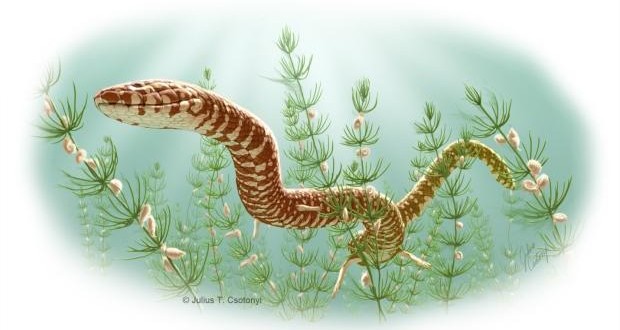The oldest known snake fossils, dating from 143 million to 167 million years ago, have been uncovered.
Researchers, writing in the journal Nature Communications, say the fossils push back the first record of snakes by 70 million years.
[fwdevp preset_id=”8″ video_path=”9SJFHsMO1BU”]“The study explores the idea that evolution within the group called ‘snakes’ is much more complex than previously thought,” says Caldwell, professor in the Faculty of Science and lead author of the study published today in Nature Communications. “Importantly, there is now a significant knowledge gap to be bridged by future research, as no fossils snakes are known from between 140 to 100 million years ago.”
New knowledge from ancient serpents
The oldest known snake, from an area near Kirtlington in Southern England, Eophis underwoodi, is known only from very fragmentary remains and was a small individual, though it is hard to say how old it was at the time it died. The largest snake, Portugalophis lignites, from coal deposits near Guimarota in Portugal, was a much bigger individual at about a metre long. Several of these ancient snakes (Eophis, Portugalophis and Parviraptor) were living in swampy coastal areas on large island chains in western parts of ancient Europe. The North American species, Diablophis gilmorei, was found in river deposits from some distance inland in western Colorado.
This new study makes it clear that the sudden appearance of snakes some 100 million years ago reflects a gap in the fossil record, not an explosive radiation of early snakes. From 167 to 100 million years ago, snakes were radiating and evolving toward the elongated, limb-reduced body shape characterizing the now well known, ~100-90 million year old, marine snakes from the West Bank, Lebanon and Argentina, that still possess small but well-developed rear limbs.
Caldwell notes that the identification of definitive snake skull features reveals that the fossils—previously associated with other non-snake lizard remains—represent a much earlier time frame for the first appearance of snakes.
“Based on the new evidence and through comparison to living legless lizards that are not snakes, the paper explores the novel idea that the evolution of the characteristic snake skull and its parts appeared long before snakes lost their legs,” he explains.
He adds that the distribution of these newly identified oldest snakes, and the anatomy of the skull and skeletal elements, makes it clear that even older snake fossils are waiting to be found.
Agencies/Canadajournal

 Canada Journal – News of the World Articles and videos to bring you the biggest Canadian news stories from across the country every day
Canada Journal – News of the World Articles and videos to bring you the biggest Canadian news stories from across the country every day

